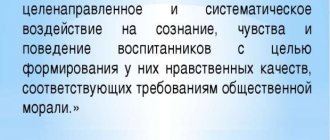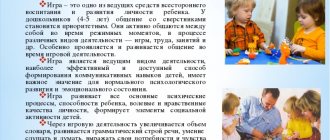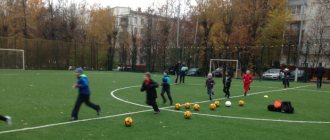According to most child psychologists, it is in preschool age that the foundation of moral education is laid. The moral education of preschool children is greatly influenced by relationships in the family, so to speak, by the “weather” in the house. It is at the age of up to 7 years that a person’s moral qualities are formed. Many parents ask questions:
At what age should spiritual development begin? What is the role of proper education of moral qualities? Is it possible to change the moral education of adolescents?
Features of the formation of moral qualities in preschool children
The Encyclopedic Dictionary defines the term morality as a synonym for “morality” and, less commonly, “ethics.” Like “ethics” in Greek, “morality” in Latin, “morality” in German etymologically goes back to the word “morality” (character). The conceptual distinction between the terms “morality” and “morality” was made by G.W.F. Hegel in his “Philosophy of Right,” where morality is presented as the last stage in the development of objective spirit from abstract law and morality. Morality is the sphere of real freedom in which the subjective will asserts itself as an objective will, which is free not only in itself, but also for itself. Morality is the sphere of practical freedom, the substantive concreteness of the will, which rises above subjective opinion and will, these are “laws and institutions that exist in us and for us.”
Explanatory Dictionary of S.I. Ozhegova defines morality as internal, spiritual qualities that guide a person, ethical standards; rules of behavior determined by these qualities.
Consequently, morality is an internal quality of a person, norms, rules of behavior by which he is guided.
Moral qualities are defined as feelings of justice, duty, honor, conscience, dignity, etc. Moral feelings prepare, adjust human behavior and activity in accordance with accepted rules and requirements, presuppose the unity of the rational and emotional, and are formed under the influence of the social environment, through the assimilation of socially accepted norms and rules. Moral feelings regulate relationships between people on the basis of assessment and awareness of moral values. They have a wide range of expressions and are involved in all moral reactions and manifestations of man.
As already mentioned in the introduction, preschool age is the most synthetic period for the formation of moral qualities. The formation of moral qualities occurs in the process of moral education, understood as a series of sequential interactions between the teacher and the team, aimed at achieving the effectiveness and quality of teaching activities and the required level of moral education of the child’s personality (R.I. Derevyanko, V.S. Mukhina, S.L. Rubinstein and others).
According to I.F. Kharlamov, the formation of morality is nothing more than the translation of moral norms, rules and requirements into knowledge, skills and habits of human behavior and their constant observance.
Moral education is a purposeful process of developing high consciousness, moral feelings and behavior in the younger generation in accordance with the ideals and principles of morality. According to V. S. Mukhina, the main function of moral education is the formation of the moral consciousness of the younger generation, sustainable moral behavior and moral feelings corresponding to the modern way of life, the formation of an active life position of each person, the habit of being guided in their actions, deeds, and relationships by feelings of public duty .
In modern science, moral education is considered one of the most important aspects of the overall development of preschool children. In the process of moral education, a child develops humane feelings, ethical ideas, cultural behavior skills, social and social qualities, respect for adults, a responsible attitude to assignments, and the ability to evaluate his own actions and the actions of others.
S.V. Peterina notes that a feature of preschool age is increased vulnerability to social influences. The strength and stability of a moral quality depends on how it was formed, what mechanism was used as the basis for pedagogical influence. Let us consider the mechanism of moral formation of personality.
In the process of communicating with adults, a feeling of affection and love for them arises, a desire to act in accordance with their instructions, to do good to them, and to refrain from actions that upset loved ones. The child experiences excitement, sees grief or dissatisfaction from his pranks, mischief, rejoices at a smile in response to his positive action, and experiences joy from the approval of loved ones.
General characteristics of the moral behavior of a preschooler
Moral development is a process that involves the assimilation of moral norms, the formation of moral consciousness and moral behavior.
Moral education is a purposeful process of introducing children to the moral values of humanity and a particular society.
The task of moral education is to ensure that universal moral values become an internal stimulus for the development of the emerging personality.
Even in preschool age, the formation of the foundations of a person’s moral qualities begins. As the child develops, he gradually masters the norms and rules of behavior and relationships accepted in human society, appropriates, i.e. makes his own, his own, the methods and forms of interaction, expressions of attitude towards people, nature, and himself. In various types of activities, children successfully develop certain ways of consciously managing their behavior, activity and independence, interest in the social environment, and feelings such as friendship and camaraderie arise.
As a result of moral education, a person acquires a certain set of moral qualities. And the more firmly these qualities are formed, the fewer deviations from the moral principles accepted in society are observed in an individual, the higher the assessment of his morality by others. Therefore, from the very beginning, it is necessary for the child to form moral feelings, ideas, concepts and, on their basis, actions that correspond to the moral standards of the society in which the child lives.
Proper upbringing prevents a child from accumulating negative experiences and prevents the development of undesirable skills and behavioral habits, which can adversely affect the formation of his moral qualities.
Mechanism and tasks, means and methods of moral education
Let us consider the mechanism of moral development of personality. To form a moral quality, a child needs knowledge on the basis of which he will form ideas about the essence of a moral quality, its necessity and the advantages of mastering it. In order for a child to have a desire to master moral qualities, it is necessary that motives arise for acquiring the corresponding moral quality. The emergence of a motive entails an attitude towards quality, which in turn forms social feelings. Feelings give the process of personality formation a significant coloring and therefore influence the strength of the emerging quality.
Knowledge and feelings generate the need for their practical implementation - in actions and behavior. Actions and behavior, in turn, allow you to check and confirm the strength of the quality being formed.
The following mechanism of moral education can be distinguished:
(knowledge and ideas) + (motives) + (feelings and attitudes) + (skills and habits) + (actions and behavior) = moral quality.
This mechanism always manifests itself during the formation of both moral and immoral qualities of the individual. Its main feature is that each component of this mechanism is important and cannot be replaced by another or completely excluded. The next feature of this mechanism is that its action is flexible. This lies in the fact that the sequence of components can vary depending on the characteristics of the quality and the age of the object of education.
The tasks of moral education can be divided into two groups.
The first group of tasks of moral education includes the tasks of forming its mechanism: ideas, moral feelings, moral habits and norms, and behavioral practices. Each component has its own characteristics of formation, but it must be remembered that when forming one component, it is necessarily expected to influence the others, since this is a single mechanism. This group of tasks is permanent and unchanging.
The second group of tasks of moral education reflects the needs of society for people who have specific qualities that are most in demand today. This is due to the fact that at each stage of its development, society solves different problems of educating the younger generation, i.e. At different stages of development, a person has their own moral ideals. Thus, this group of tasks is of a moving nature. Its content is influenced not only by the historical stage of development of society, but also by the age characteristics of the object of education and specific living conditions.
For the second group, the tasks of moral education of preschoolers were grouped into four semantic blocks:
- education of humane feelings and relationships;
- education of patriotism;
- education of hard work;
- education of collectivism.
Moral education is carried out using certain means and methods. Means of moral education are divided into four groups.
- Artistic media are fiction, visual arts, music, cinema, filmstrips and other media. This group contributes to the emotional coloring of cognizable moral phenomena, and is also most effective in forming moral ideas and nurturing feelings in children.
- Nature - makes it possible to evoke humane feelings in children, the desire to take care of those who are weaker, who need help, to protect them, and contributes to the formation of self-confidence in the child. It is a significant means of educating feelings and behavior.
- Children’s own activities – play, work, learning, artistic activity. Each type of activity has its own specificity, performing the function of a means of education, but this means - activity as such - is necessary when developing the practice of moral behavior. A special place in this group is given to communication as a type of activity. Communication as a means of moral education best fulfills the task of correcting ideas about morality and cultivating feelings and relationships.
- The atmosphere in which the child lives: the atmosphere can be friendly, or it can be cruel and immoral. The environment that surrounds the child becomes a means of educating feelings, ideas, behavior, i.e. it activates the entire mechanism of moral education, influencing the formation of certain moral feelings.
Some authors also highlight specific means
corresponding to different areas of child upbringing, for example, corresponding to the means of labor and moral-labor education.”
The choice of means of education depends on the age of the object of education, on the level of his general and intellectual development, on the stage of development of moral qualities.
The means of moral education becomes more effective in combination with adequate methods and techniques of education. In pedagogy, there are several approaches to classifying educational methods. However, we can focus on the classification of V.I. Loginova, based on the activation of the mechanism of moral development in the process of education and including the following methods:
- Stimulating feelings and relationships (example of adults, encouragement, punishment, demands);
- Formation of moral behavior (training, exercises, activity management);
- Formation of moral consciousness (persuasion in the form of explanation, suggestion, ethical conversations).
All methods give effective results only if certain conditions are met:
- Any method must be humane, not humiliating to the child, and not violating his rights.
- The method must be real, feasible, it requires a logical conclusion.
- To use the method, conditions and means must be prepared in advance.
- The method should not be applied in the same way, stereotyped way to all children and in any situation.
- Parenting methods should be used tactfully.
- When selecting methods, the degree of complexity of the quality being formed should be taken into account.
- When designing and selecting methods, it is important to foresee the possible results of their impact on a particular child.
- The application of moral education methods requires tolerance and patience.
- Practical methods that involve teaching the child methods of action should prevail in the moral education of preschoolers.
- The methods are not used in isolation, but in combination, in conjunction.
The moral education of a child is directly related to his social development. These two processes are closely intertwined with each other.
Social and moral education in preschool age is determined by the fact that the child forms the very first moral assessments and judgments.
Forms of organization of social and moral education:
— organizing joint activities between adults and children
— organizing independent activities for children
“The results of social and moral education:
- social and moral feelings - experiences associated with the satisfaction or dissatisfaction of the child’s aspirations to comply with the requirements of social life, to follow moral standards;
- socio-moral culture - the degree to which an individual perceives the culture of communication, the level of people’s knowledge of universal humane norms and principles of morality, the subordination of their behavior to these requirements, the struggle for their implementation;
— social and moral qualities are permanent personality qualities that manifest themselves in all situations and are associated with a person’s (child’s) desire to follow moral standards.
— social and moral values are guidelines in the behavior of social groups, allowing one to evaluate social phenomena and the actions of people, their ideas about good and evil from the moral side.”
Thus, we can distinguish the following stages of personality formation in the process of moral education:
— formation of social emotions and moral feelings;
- accumulation of knowledge and formation of moral ideas (can go in parallel with the first stage).
— the transition of knowledge into beliefs and the formation on this basis of a worldview and value orientations;
- the translation of beliefs into concrete behavior that can be called moral.
Motive as a regulator of child behavior
The main tasks of moral education of preschool children include the formation in the child of moral feelings, positive skills and habits of behavior, moral ideas and motives of behavior.
Feelings develop most intensively in preschool age; they encourage children to take active action. In preschoolers, they are distinguished by sincerity, instability, and spontaneity.
In preschool age, the first experience of moral behavior is accumulated, the first skills of organized and disciplined behavior, positive relationship skills, independence skills, etc. are formed. These skills are reinforced and turned into habits.
When calling on children to act in a certain way, an adult must explain the appropriateness and correctness of such behavior. Explanations should be carried out using examples that help the child gradually understand the moral concepts accepted in society. It is necessary for children to understand the essence of moral concepts and be able to relate their own and others’ specific actions to them. During this process, children form general ideas about how to act in a particular case. Formed moral ideas serve as the basis for the development of motives of behavior that encourage children to perform certain actions.
The moral education of a child is considered as a process of assimilation of behavior patterns set by society, as a result of which these patterns become regulators (motives) of the child’s behavior. If we consider the problem of moral behavior from the point of view of motivation, then preschool children act according to a moral motive not because they can consciously control their behavior, but because their moral feelings have greater motivating power than other motives. This happens because the child strives to meet the requirements and expectations of adults.
Preschool age is a transitional period from the external, formal acceptance of adult demands to their assimilation and transformation into motives for behavior.
The motivational orientation of a person’s behavior is a steadily dominant system of motives, or motivational formations, that is, it reflects a dominant that becomes a vector of behavior. The positive orientation of the motives of behavior is manifested in benevolence as an emotional expression of the child’s attitude towards others, as a manifestation of the child’s attitude towards his own actions.
In order for the child’s moral knowledge to turn into his beliefs, and, consequently, into the motives of his behavior, constant practice of the child’s social behavior is necessary, where he actually learns to act in accordance with the interests of other people and in the interests of the entire team, in order to achieve socially significant goals . During this practice of social behavior, the child develops moral feelings and habits, which are the basis for the assimilation of moral norms and rules.
Moral experiences can become motives for actions only if a person has the necessary experience of moral behavior and the conditions for exercising moral actions.
The formation of moral actions and moral habits is the education of moral behavior in preschoolers.
An action characterizes a person’s attitude to the surrounding reality. Moral habit is the need to perform a moral act. To form a habit, it is necessary that the motives by which children are encouraged to act are significant in their eyes, so that children, if necessary, are able to show certain efforts of will to achieve results.
In order for a child to develop stable, habitual moral behavior, the correct organization of the entire system of educational influences is necessary.
A correct understanding of a person’s moral character, his attitude towards other people, towards himself should become a role model for the child. It is necessary that the child’s moral ideas become the driving motives of his behavior.
Thus, one of the important tasks of the moral education of a preschooler is to instill in him socially valuable motives of behavior.
Morals and ethical rules
Moral rule and moral norm, used as synonyms in literature, are separated in pedagogy.
Rules and norms are an established order of actions and relationships. A rule can be single, related to a specific situation, to a specific subject, and has a particular and narrower meaning. Rules are imposed on a child by adults, and cannot be understood and understood by preschool children, as J. Piaget believed. However, he still identified three stages of children’s awareness of the rules.
The first stage - the child is not yet aware of the rule, but is formally applied.
The second stage - the rule is applied by the child in its unchanged form and cannot be broken.
The third option is that the rule is considered as a law, and it can only be changed with general consent.
The moral norm is more general in nature, characterizes the general direction of relationships and behavior and is specified by the same rules.
Moral norms reinforce the social behavior of a preschooler.
Moral norms that are already familiar to the child do not immediately begin to guide the child’s behavior. At first, he performs them only at the request of an adult or under his control, and he can easily violate them. The child does not notice these violations themselves and does not give a negative assessment of himself, but only negatively evaluates such behavior in general.
Then, having mastered the norms, the child begins to control the behavior of his peers, because It is easier for him to see and evaluate the presence of moral qualities and the fulfillment of standards by a peer than by himself. Often a child correctly assesses the fulfillment of moral standards by a peer and is mistaken in assessing himself. The child makes statements towards the adult in which he reports violations of the rules by one of the children, and in this case the child wants to confirm whether he correctly understands the norm or rule. Gradually, evaluating a peer, comparing his behavior with his own, listening to the assessment of his actions by adults, the child approaches the formation of real self-esteem.
In older preschool age, a moral norm begins to act as a regulator of relationships between people. The child moves from spontaneous to conscious morality. The need for control by an adult disappears; the child’s behavior becomes moral even in the absence of an adult.
The example of an adult plays an important role in teaching a child to follow the moral standards accepted in society. A norm that an adult only pronounces, but does not observe himself, will never influence the child’s behavior. This leads to the fact that the child begins to understand that moral standards can be violated with impunity or not observed at all. Two options can be observed in a child’s behavior when he violates moral norms. The first option is that the norm is violated unconsciously; the child acts under the influence of situational desires. The second option is a conscious violation of norms, when the child realizes the contradiction between his behavior and the socially approved pattern of behavior. Here we should talk about misconduct. Repeatedly, misconduct forms a style of behavior, is reinforced and turns into a habit.
Also, in preschool age, an adult’s assessment of his actions plays a huge role in a child’s behavior. A positive moral assessment by an adult gives a positive connotation even to those actions that were usually performed by a child with complete indifference. With the help of a positive assessment, an adult fixes the correct way of behavior, with the help of a negative one, he destroys the negative way. In this case, the assessment of an adult must meet certain requirements:
- be objective and at the same time tactful;
- be focused on the child’s own behavior;
- be differentiated, since general assessments do not provide anything for the development of the child’s personality;
- be systematic, and not given from case to case;
- include a combination of verbal and non-verbal methods of influence.
The development of moral judgments and evaluations is a necessary but not sufficient condition for moral development. The main thing is to create conditions when the norm of morality begins to regulate the child’s behavior, that is, to establish a connection between moral consciousness and moral behavior. In this case, the norm becomes a motive for behavior and performs a motivating function. The child’s consciousness switches to the process of fulfilling the norm, and he follows it for its own sake, because he cannot do otherwise.
The relationship between moral consciousness and behavior is established when the child is trained in moral actions, placed in a situation of moral choice, and the child decides independently what to do. By making a choice in favor of following the norm, the child ultimately receives satisfaction from his action. Gradually, this behavior becomes a habit and the child develops a need to comply with the norm of behavior.
Culture of behavior and morality
The concept of moral behavior is closely related to such a concept as culture of behavior.
Culture of behavior is a broad, multifaceted concept that reveals the essence of the norms and rules of human behavior in the system of the most significant, vital relationships: relationships to people, objects of material and spiritual culture, activities and to oneself.
A culture of behavior is the sustainable forms of behavior accepted in society in everyday life, communication, and various activities that comply with moral norms and rules.
The task of moral education of a preschooler is to lay in him the foundations of a culture of behavior, during which to form stable moral habits of the child’s cultural attitude towards himself and the people around him.
The concept of culture of behavior includes such concepts as:
- everyday culture,
- culture of communication,
— behavioral culture,
— culture of activity.
Household culture includes the child’s hygienic culture, adherence to the rules of a healthy lifestyle, the culture of handling household items, toys, personal and public things.
The need to observe basic rules of cleanliness is dictated not only by hygiene requirements, but also by the norms of human relations. By the end of preschool age, children should have formed stable habits of a culture of everyday behavior.
The culture of communication is manifested in the ability to organize communicative activities in which the content of information, behavioral and speech means contribute to the establishment of moral relationships and mutual understanding between communicants. Formed on the basis of traditions and norms of communication that have developed and accepted in society, the culture of communication allows a person to quickly find understanding and support for the social environment in which he lives. It is necessary to form a positive communication experience for children from an early age, since its absence leads to the spontaneous emergence of negative forms of behavior in them. The culture of communication of preschool children determines the norms and rules of the child’s relationships with people of different ages in the family, kindergarten, and public places. The culture of communication is a necessary condition for the moral development of the individual and the most important component of the general behavioral culture.
A culture of activity presupposes that children observe the elementary rules of organizing and carrying out individual and joint activities, compliance with the norms of cooperation, responsibility, and organization. The culture of activity is manifested in the child’s behavior in classes, games, etc. An indicator of a child’s culture of activity is the ability and desire to work, a craving for interesting, meaningful things, and the emergence of volitional effort to achieve a goal.
Thus, the cultural behavior of a child is based on moral habits, ideas about good and evil, justice, and the need to behave with dignity. As mentioned above, the means of educating a child’s behavior are moral education, personal example of adults, persuasion, pedagogical tact, measures to prevent negative actions, encouragement and punishment. First of all, the foundations of morality are laid in the family.
In preschool pedagogy, the culture of behavior is interpreted as a system of skills in which the content of information, behavioral and speech means serve to establish moral relationships between children.
Pedagogical conditions for developing a culture of behavior:
- speech and behavioral culture of adults;
- thoughtful, rational organization of the child’s lifestyle;
- a diverse subject-development environment that satisfies the needs of preschoolers in communication and activity;
- interaction between teachers and parents of preschool children;
- designing a meaningful life for children, an “event scenario” that ensures the accumulation of experience.
A necessary condition for fostering a culture of behavior is to ensure the child’s emotional and comfortable state: his emotional manifestations, the child’s communication and interaction with peers and adults, and personal behavioral traits.
In instilling in children the skills and habits of cultural behavior, it is necessary to observe the principle of unity and integrity of the tasks, methods and means of moral education. It is necessary to form the effectiveness of moral feelings, the desire for actions based on socially valuable, moral motives.
In the process of cultivating a culture of communication in preschoolers, it is necessary to influence all aspects of the communicative process: its content, methods of verbal and practical interaction and the corresponding moral ideas of preschoolers about the norms, rules of behavior and communication, moral qualities and actions of people.
The child’s behavior culture should be based on goodwill, respect, politeness, and the desire to achieve mutual understanding with the people around him. In the course of developing a culture of behavior, it is necessary that the requirements for the child’s behavior be formulated by adults in a form simple and understandable to the preschooler; these rules are formulated not in a general form, but specifically, indicating the action that the child needs to perform in certain circumstances, it must be addressed personally to the child.
During preschool age, the rules of behavior culture become more complex and their volume increases. Gradually, they begin to determine not only the individual actions and deeds of the child, but also his entire way of life from the standpoint of moral and cultural requirements. At the end of the senior preschool age, children not only know many rules, but are also able to understand why they need to be followed. Children experience a sense of satisfaction if adults approve of their behavior and associate the ability to follow cultural rules with increasing independence and maturation. Gradually realizing the value of rules, children begin to actively use them, and gradually this becomes the norm of their behavior.
Thus, the preschool moral education of a child must be combined with the utmost respect for his personal merits. When shaping moral behavior, adults must take into account the child’s existing moral experience. The formation of the foundations of a child’s moral behavior should not be accompanied by the suppression of his initiative and individuality.
Looking closely at the world of adults, the child begins to highlight the relationships between people in it. By comprehending the world of human relations, he discovers the laws by which human interactions are built, that is, norms of behavior. Growing independence and awareness of behavior leads to the development in a preschooler of the ability to be guided in his actions by learned moral standards. As a result, he develops internal ethical motives that determine his behavior.
Features of moral qualities of preschool children
- Humanity means sympathy, empathy, responsiveness, compassion. Therefore, an indicator of the formation of a personal quality is the nature of the attitude towards people, nature, and oneself. The humanity of a preschool child is based on the ability to understand another, to transfer the experience of another to oneself. The formation of a humane attitude towards people and nature begins in early childhood. Systematic work aimed at instilling in preschoolers a humane attitude towards people and the surrounding nature leads to the formation of humanism in them as a moral quality. In other words, humanism is a qualitative characteristic of a person. At the same time, the development of humanistic feelings and attitudes is a complex and contradictory process. The ability to empathize, sympathize, rejoice, not envy, and sincerely and willingly do good develops especially in preschool age.
- Collectivism is a moral quality of preschool children based on the formation of positive, friendly, collective relationships. The main and only function of the children's team is educational: children are involved in activities that, in terms of their goals, content and forms of organization, are aimed at shaping the personality of each of them. For the formation of collective relations, the emergence of such a phenomenon as friendship is essential. Friendship, as the closest connection between children, accelerates the process of effectively perceiving social relationships. Mutual support and responsiveness are integral features of collective relationships. Children's relationships are determined by moral rules and norms. Knowledge of the rules of behavior and relationships makes it easier for a child to enter the world of his own kind, the world of people.
- Patriotism and citizenship are not yet fully formed in preschool age, but their foundations have only been laid. Therefore, education of the principles of patriotism and citizenship is one of the most important parts of the moral education of preschool children. The feeling of love for the motherland is associated with the feeling of love for the motherland. These feelings are associated with a common basis - attachment and a sense of security. Thus, if we cultivate in children a sense of affection as such and a feeling of attachment to home, then with appropriate pedagogical work this will ultimately be complemented by a feeling of love and affection for their country.
- A value-based attitude towards work is an awareness of the importance of work in a person’s life. A distinctive feature of a value-based attitude to work is that it is a moral quality of a preschooler, which integrates such moral qualities as tolerance, empathy and helpfulness. Preschoolers' attitude to work includes respect for others.
- Dialogue is the preschooler’s readiness to interact with other people, listen and understand them.
In addition, in most studies, the most important moral qualities are kindness, politeness, sensitivity, tact, modesty, helpfulness, sociability, and discipline.
As a result of the systematic formation of the moral qualities of the personality of preschoolers, their relationships with other people acquire features of a moral orientation, and the ability to manage their actions and feelings on the basis of moral requirements develops. Children's moral ideas become more conscious and play the role of regulators of children's behavior and relationships with others. Independence, discipline, responsibility and self-control are actively formed, as well as a number of habits of cultural behavior, the ability to maintain friendly and friendly relationships with peers, and to show respect and attention to elders. The foundations of social, patriotic and international feelings are developing. All this, as a rule, indicates successful moral development and constitutes the necessary moral and volitional readiness for schooling.
The concept of moral education
Modern Russian society finds itself at the epicenter of moral and ethical problems.
The processes of globalization and universalization affect the culture of the country, the destruction of traditional national spiritual values occurs, as a result of this, social evil increases, as well as moral mistrust of each other intensifies, interpersonal and interethnic conflicts are perceived as a common occurrence, empathy disappears, a tendency is established to destroy national cultural traditions, the ideals of young people are reoriented from spiritual to material. The question of the ethical dimension of the negative consequences of imposing elements of Western living standards on our society remains relevant, which further aggravates the crisis of spirituality in Russian society. This can be seen in the devaluation of morality and moral imperatives, as well as in the absence of humane attitudes at the level of interpersonal relationships, thanks to which the full development of personality occurs.
Are you an expert in this subject area? We invite you to become the author of the Directory Working Conditions
Russian society, more than ever, requires the presence of a socially valuable and spiritually stable personality, a “moral person” with a high level of culture, capable of becoming a responsible, active, active subject of social development.
Among researchers there is no definition of the concept of “moral education”; they characterize it as:
- complex integrated process;
- the process of formation of moral qualities, character traits, skills and habits of behavior;
- a social phenomenon that obeys the laws of social development;
- purposeful influence of the older generation on the younger generation in order to develop stable moral qualities in them;
- a purposeful process of organizing and stimulating diverse activities and communication, aimed at mastering a moral culture of behavior and attitude towards the surrounding world;
- a process whose specific functions are carried out according to its own rules and patterns;
- the core of harmonious personality development;
- the form of transformation of experience and the sphere of implementation of human moral culture;
- development of skills and abilities of moral behavior, formation of humane relationships.
Finished works on a similar topic
Course work Moral education - goals, features, methods 420 ₽ Abstract Moral education - goals, features, methods 280 ₽ Test work Moral education - goals, features, methods 200 ₽
Receive completed work or specialist advice on your educational project Find out the cost
The role of communication with peers in the formation of moral qualities of preschool children
In recent decades, the field of communication as a whole has attracted the attention of researchers. The nature of communication, its age-related and individual characteristics, the mechanisms of its flow and changes have become the object of study by philosophers and sociologists (B.D. Parygin, I.S. Kon), psycholinguists (A.A. Leontiev), social specialists (G.M. Andreeva, B.F. Porshnev), child and developmental psychology (Yu.L. Kolominsky, V.S. Mukhina).
The problem of communication between preschoolers and peers, that is, the role and functions of communication with peers in the life and mental development of a child, is becoming increasingly relevant.
Let's consider some information about the vital function of communication that can be found in domestic and foreign literature. B. Spock, pointing out the importance of communication with peers, advises parents to facilitate contacts between children: “Systematically teach children to exchange toys and share treats, whenever possible, bring the child into the company of other children (at least 1-2 times a week for 2-3 hour); and even a one-year-old child, the author believes, should be taken to where there are children.”
According to the idea of J. Piaget, communication with peers is the most important factor in the development of a child, which contributes to the destruction of egocentrism. He argued that only by sharing the views of a child's peers - first other children, and as the child matures - adults - can genuine logic and morality replace the egocentrism inherent in all children, both in their interactions with other people and in their thinking (Piaget, 1965).
S.L. Rubinstein, on the contrary, warned that love for one’s neighbor “with whom one gets along” can easily turn into “extended egoism,” and “egoism” in a double sense is ... detachment from all people. It is likely that communication with other people allows one to overcome the isolation of the child’s social world and make changes in his psyche.
G.A. Zuckerman believes that communication with peers contributes to the development of criticality of opinions, words and actions, their independence from the judgments and desires of others. V.S. Mukhina, noting the multiple influence of communication with peers on the development of a child’s personality, writes that in preschool age, public opinion is first formed and the phenomenon of comfort appears. “...Children begin to listen to the opinions of their peers and obey the opinion of the majority, even if it contradicts their own impressions and knowledge.”
A.N. Leontyev noted that in the first 7 years of life, children consistently develop four forms of communication with adults: intuitive-personal, situational-business, extra-situational-cognitive and extra-situational-personal. An approach to analyzing communication between preschoolers and peers can be based on the theoretical proposition that the nature of both areas of communication between preschoolers is the same. A child’s communication with an adult and a peer are variants of the same communicative activity. The main thing that unites both spheres is the subject of activity, which in both cases is another person, the child’s communicative partner. Consequently, communication with a peer for a preschooler is a communicative activity that is similar in essence to communication with an adult, and to analyze it, one can apply the scheme and techniques developed in the study of communication with adults.
Thus, the need for communication with peers is formed in preschoolers in the third year of life; it is formed on the basis of previously functioning needs and is formed in the real interaction of children.
M.I. Lysina and L.N. Galiguzova note that after identifying a child’s communication skills, we are not talking about the development of communication needs as a whole, but about a qualitative transformation of the content of the child’s need for communication.







